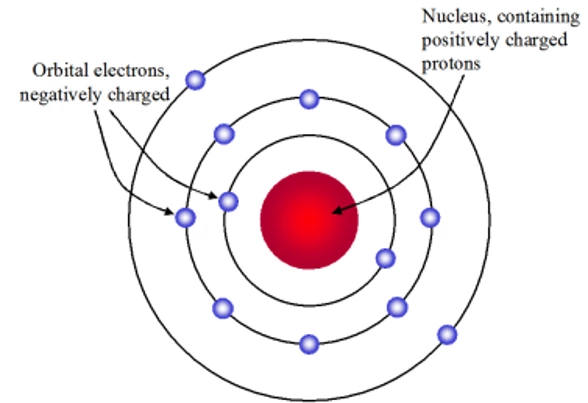Rutherford Atomic Model
Rutherford Model of an Atom
Rutherford was always curious in knowing about the arrangement of electrons in an atom. By performing an experiment using alpha particles and gold foil he came to some conclusions. Let’s look at the best Rutherford atomic model.

Experiments performed
Let us initially pick up something about the trials he showed:
- A 1000 atoms thick gold foil was chosen since he needed as thin a layer as could be expected under the circumstances.
- Alpha particles are only doubly charged helium particles. As its mass is 4u, the quick-moving alpha particles have a great measure of vitality.
- He expected that the alpha particles will be avoided as they are heavier than the protons. In any case, what he watched was totally sudden, he mentioned the accompanying objective facts:
Most of the alpha particles went straight through that gold foil. There was an avoidance by little point by a portion of the alpha particles. Very modest quantity of alpha particles bounced back.
Rutherford finished up the accompanying focuses after the perception:
1. As there was less redirection of alpha particles so he reasoned that a large portion of the space was vacant in an iota.
2. He additionally inferred that positive charge contains extremely less measure of room in an iota as not very many articles were avoided from their way.
3. A modest quantity of alpha particles diverted with a point of 1800, which demonstrated that the mass of the iota and the positive charge were aggregated at a little volume in a molecule.
From every one of these perceptions, he determined that the range of the core is around multiple times not exactly the sweep of the particle.
Rutherford put the accompanying last model after every one of the perceptions:
• The core is at the inside and is decidedly charged and about all the mass of the core lives in the core.
• Around the core, electrons spin roundly.
• The size of the core is extremely less when contrasted with the size of the particle.
Drawbacks of Rutherford's Model:
• Accelerated charged molecule produces electromagnetic waves (Maxwell Theory), so the orbital range of electron ought to continue diminishing lastly, electron should fall into the core. In any case, molecules are steady and this steadiness of iotas couldn't be explained by Rutherford's model.
• The model didn't discuss electronic structure of iotas, viz. electrons direction, their orbital movement and relative vitality of electron in various circles.
• Dual character of electromagnetic radiation couldn't be explained by the model
Numerical Problems: Hydrogen atom has ground state energy of -13.6eV. What are the kinetic and potential energies of atom at this state?
Solution: Given: Total energy= -13.6eV
We know from the above equations: Kinetic energy(K)= -Total energy(T)
∴ K = -(-13.6eV) = 13.6eV (ans)
Potential energy(U) = 2×Total energy(T)
∴ U = 2×(-13.6eV) = -27.2eV (ans)
Note: Here negative sign shows that there is a force of attraction between electron and nucleus.

Similar Questions
Atomic Models|Dalton's Atomic Model|Reason Of Failure|Thompson's Atomic Model|Rutherford's Atomic Model|Distance Of Closest Approach
View Solution||Discovery OF Electrons||Protons||Thomson’s Atomic Model||Rutherford’s Alpha Particle Scattering Experiment||Rutherford’s Atomic Model||Distance OF Closest Approach||
View Solution
Knowledge Check
- Question 1 - Select One
Rutherford's atomic model was unstable because
Anuclei will break downBelectrons do not remain in orbitCorbiting electrons radiate energyDelectrons are repelled by the nucleus - Question 2 - Select One
Rutherford's atomic model was unstable because
Anuclei will break downBelectrons do not remain in orbitCorbiting electrons radiate energyDelectrons are repelled by the nucleus - Question 3 - Select One
Rutherford's atomic model could account for
Astability of atomsBorigin of spectraCthe positive charged central core of an atomDconcept of stationary orbit
Thomson's Model (Plum Pudding Model)|Drawbacks Of Thomson Model|Rutherford's Nuclear Model|Observation Of Gold Foil Experiment|Conclusion Of Rutherford By Gold Foil Experiment|Rutherford's Atomic Model|Drawbacks Of Rutherford's Atomic Model|Representation Of Atom|Some Important Terms Related To Atoms|Electromagnetic Wave Theory|Some Important Characteristics Of A Wave|Relation Between Wavelength And Frequency|Electromagnetic Radiations|OMR
View SolutionIntroduction, cathode and anode rays, thomsons atomic model, rutherfords scattering experiment, rutherfords atomic model
View SolutionDescribe Rutherford atom model. What are the drawbacks of this model?
View SolutionAccording to the Rutherford's atomic model, the electrons inside the atom are
View SolutionAccording to Rutherford's atom model, the proposed path of an electron will be
View Solution

